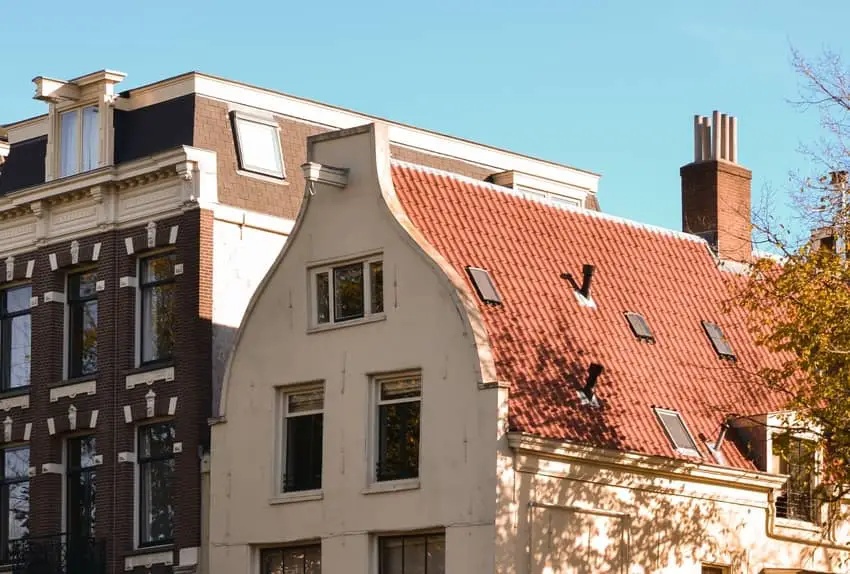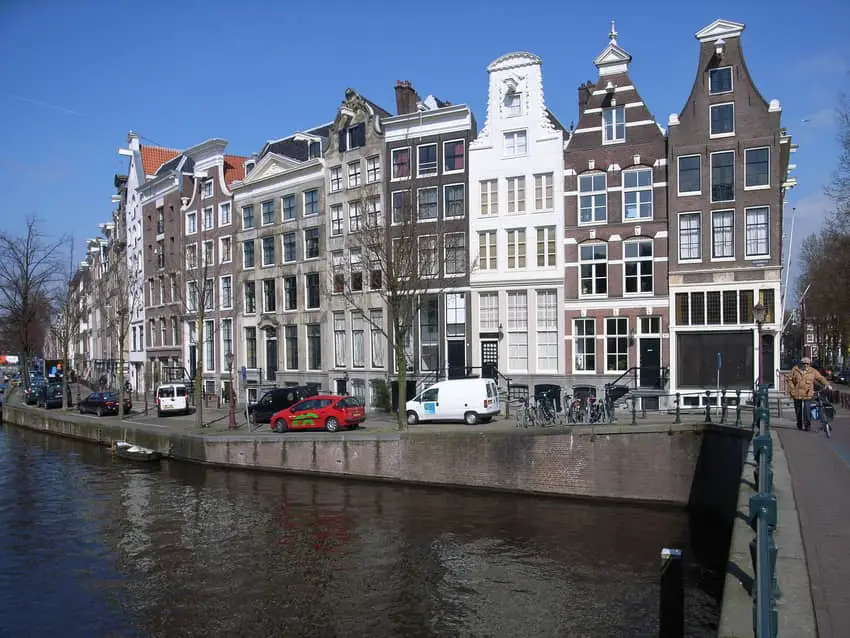Have you ever seen someone moving in the Netherlands? Most of the movings looks exactly the same as in any other country, boxes, chaos and bulky furniture everywhere. However, if you have the opportunity to see someone moving in Amsterdam you will see these hooks in action, helping move big pieces of furniture up and down the buildings.
The characteristic hooks located in the top of Amsterdam houses serve to pull goods up the houses using a wheel and rope. This is a Medieval technique that still works nowadays and both old and new construction feature them. Using the narrow staircases of Dutch houses is not an option.

Amsterdam’s architecture does not only consist of beautiful brick buildings but also all the little details featuring them. If I have learnt something out of my years living in the Netherlands is that Dutch people are practical and pragmatic. If they invent anything is to fulfil a need and they may make it pretty in the meantime.
A Brief History of Building Hooks
Like most of the famous buildings and history of Amsterdam, it goes back to the Medieval Ages with the foundation of what has become nowadays the capital of the Netherlands.
The Golden Ages represent the years of highest cultural and economic growth of the Netherlands, and of course, that includes the architecture of Amsterdam. Back in the day, as it tends to be also nowadays, those who could afford to construct big buildings around the canals and the most popular areas of the city were rich people. In the case of the Netherlands, these tend to be traders and business people who would also use the canals as a way of developing their business.
Business people would normally have not only their formal residence in those houses but also their business, making very important the storage of these goods. Living in an overflowing country that had to fight against the rising water level, keeping these goods dry and properly stored was the main goal, so these houses were constructed in order to be able to pull up and down the top floors anything that needed to be stored: furniture, goods, boxes, instruments, food, are winched up using a rope and pulley, and hauled in through the wide windows of the upper floors.

Houses constructed around the Grachtengordel (and most houses constructed in Medieval times as well as some new construction ones), were made very narrowed, because of current laws: narrow houses imply narrow stairs and very little space to make anything (including grocery shopping) hard to transport up the stairs.
The first ones to use it was the Flemish territories in the 14th Century, expanding first to Utrecht and the new constructions (including the Dom) and later on in Amsterdam, when the beginning of the new architectural movement started in the 15th Century after wooden buildings were banned after the big fires of that century.
Amsterdam Buildings
Besides the hooks on the top parts of the building there are a lot of characteristics features in Dutch buildings that would refer back to the function they clearly fulfilled back in the day, among them:
- Little Windows: on the upper floor, always next to the hook, buildings had a small winnowed. If you ever go close to them, you will see that some of them are only big enough to get out your head or your arm. This means that the main function of them was to make easier pulling up a robe, installing the wheel and checking out what you were doing.
- Big windows: on the rest of the floors of those constructions, one can normally find very big windows. There are several reasons why this was made that way, among them, making easier to help the furniture inside the buildings. Other popular reasons why big windows were constructed was, of course, to make the inside of the buildings much less dark, making the most out of the little sun the winter Dutch (and sometimes the summer) gives you.
- Crooked buildings: if you want to know all the reasons why Amsterdam buildings are leaning forward, you can check my latest article here. One of the main reasons why this is the way it is, it is related to the existence of hooks. Leaning forward buildings were purposely made that way, considering the transportation of goods to the upper floors of the buildings, the position of the building would help neither the buildings and windows, neither the furniture and boxes to get ruined during the transportation, making it either for them not to touch each other.
- Fully open windows: I don’t know if you have ever been to any cold countries, but using England as an example, their windows tend to only be able to open from the lower half only. This means that in order to keep the heat inside and avoid wasting energy, the constructions are as isolated as they can be. Why can Dutch windows open fully and completely? Weren’t they practical people? Well, yes, that is why they open, so that it is easier to use them to fit inside any of the floors, anything that needs to go there, without using the stairs one again.
- Beams: these are also a very important part of the weight lifting process. Hooks tend to be hanging from the main beam that keeps the structure of the dual-pitched roof. This means that the weight falls in the main structure of the house and it is safe to lift up to 400kg with most of them.
- Gables are also an important part of the heavy lifting process: Besides being one of the main decorative features of Amsterdam houses, gables also help, creating a firmer structure to make possible for these structures to resist all the heavy weight lifting. A gable is the section of wall between the edges of a dual-pitched roof, another one of the main features of Amsterdam houses. These gables are visible on the tall elegant canal houses in Amsterdam, providing both an aesthetic and functional purpose through their winches.
Curiosities about Amsterdam Buildings
As I was saying before, there are a lot of small details one can find in buildings in Amsterdam that make them special. Even though all of them look similar, they have many characteristics that make them belong to a different architect, family, time and have a different function. Find out more!
Hooks in buildings change according to the artistic movement of the time they were made. Of course, they are thought to fulfil a specific task but they also blend amazingly well with the design of the building. If you are curious to know all the styles, the materials they are made of, and mostly the original designs, Oog voor Detail, a Dutch website (sorry, also in Dutch) features most of the types of hooks there are in Amsterdam.
Even though you can find them everywhere in Amsterdam, if you want to find curious hooks, you have to walk around Vondelpark in the direction of Museumplein and the Concertgebouw. It is true that this area is not in the canal ring but the owners of these properties and the architects who designed them had a lot of fun finding the best way to make something beautiful out of a simple building hook. Make sure you find the unicorn!

In Dutch they are called Hijsbalk, which literally means hook to lift up things. Very pragmatic!
Nowadays houses also have hooks. Most of the new constructions that have been made in touristic areas or centric areas, using the original structure of old Dutch houses, also use hooks to transport furniture upstairs. There are companies that exclusively dedicate to these hooks and even make a 2 or 5 years check to make sure you are in no danger and can keep using your hook.
Amsterdam houses are also leaning forward because of a strategic weight lifting characteristic but for many more reasons you can read here.
Nowadays, hooks are also very much used in the Netherlands and Flemish territories but mostly in the ports of these cities. Like everywhere else in the world, years ago these hooks were used to move big masses of goods from the ships into the ports. In this area, you can also find old hooks and constructions with those close to the sea.
If you want to have fun checking the amazing buildings and its characteristic hooks, I recommend you visit the Red Light District as well as the proximities of Vondelpark, Museumplein and all the Zuid-Amsterdam area, besides going for the typical canal ring tour.
Hooks in buildings are a characteristic of most Dutch and Flemish buildings, therefore not something exclusive of Amsterdam. If you want to do a day trip or visit other cities near Amsterdam, you will also be surprise to find them in way smaller and humble houses, or instance, in Amstelveen and Zaandam.